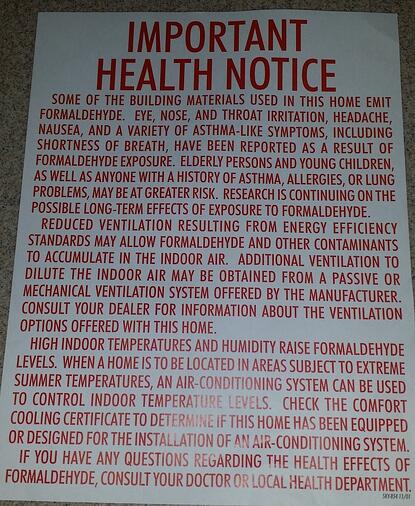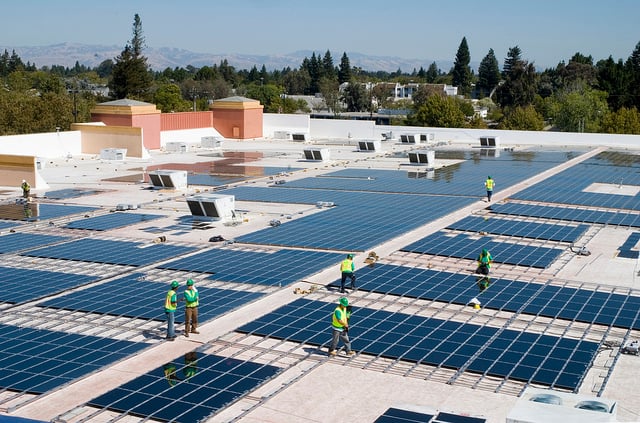Last night I got to spend time with two of my closest friends. We were showing off the well-insulated basement of our new home, and my friend relayed the story of his contrasting clients. For one client he is upgrading the basement and planned to use closed cell spray foam as the insulation material. The client became concerned about off-gassing just before the application and put the project on hold. A different client (an elderly couple) is selling their home and moving into a new trailer. Tom went to install the baseboard trim for them as a favor. When he arrived on site he found the new trailer to be virtually uninhabitable for him and his crew without the windows open. On the kitchen counter he found this label:
Energy Efficiency and Air Quality Are Both Possible
Who is the bad guy here? The energy efficiency measures that make the homes reasonably tight so occupants don’t end up paying exorbitant energy costs appear to be blamed in this warning for increasing the risks from formaldehyde exposure. The fundamental tenant for construction should be to maximize the health of the built environment. We are building these structures primarily for human occupancy. Humans need clean air free from harmful chemicals, we need natural light, and we need shelter that maintains comfortable temperatures when the outside environment is reaching new extremes -- not toxic living environments. Basic indoor air quality should be a given.
Why is it acceptable to us as a society to allow businesses to build homes that require warning labels? Non-toxic materials exist and the incremental cost is insignificant compared to the health costs of creating environments for people to live in that will make them sick. What kind of society puts profits over human wellbeing? Do you want to live in a home like this? Do you want your children or your elderly parents to live in a formaldehyde intensive environment?
We have become numb to the callous treatment of people with few options and limited access to the mechanisms of change.
Lack of Regulation
On a less egregious front, I continue to be shocked by the poor quality windows and doors that we persist in selling to people and incorporating into our buildings in the US. It is almost as if we dare ourselves to be as bad as we can be, just because we hate regulation. Without regulation, the Cuyahoga River would still burn periodically. Without regulation, the acidification of our northeast rivers, lakes and forests would be occurring even faster.
As an alternative to these toxic mobile homes, Efficiency Vermont has partnered with Vermod, a mobile home manufacturer in White River Junction, VT to develop high performance modular homes. These homes hit all of the marks – low VOC materials, high performance envelope, and energy recovery ventilation systems. They do cost more to purchase than the typical toxic, inefficient homes, but they cost less to own due to lower energy costs.
We can do the right thing, but it becomes increasingly apparent that as a society we won’t do it unless either the market or the regulators demand it. Given the warning label above it seems like it is time to mandate minimum indoor air quality standards for new homes.




